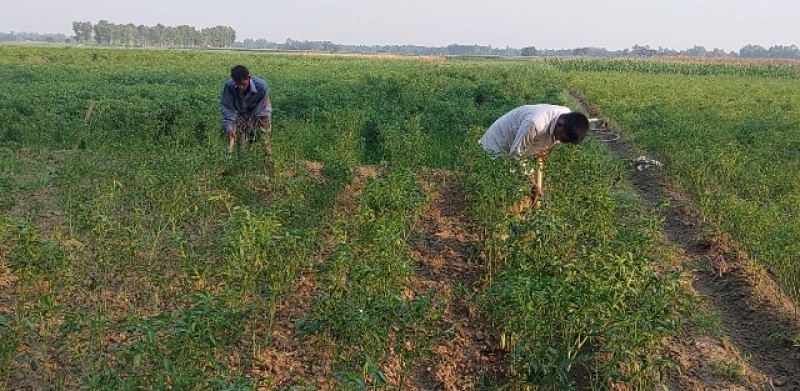- Guterres Urges Leaders to Act as UNGA Week Begins |
- BNP to go door to door for hearts and votes |
- Chittagong port tariffs increased up to 50 per cent |
- Rising Heat Cost Bangladesh $1.8 Billion in 2024 |
- Stocks extend gains; turnover drops in Dhaka, rises in Ctg |
Chili growers in Manikganj worried over low yield due to drought

Chili field in Manikganj
Manikganj, Oct 15 - Amid the skyrocketing prices of daily essentials, including vegetables, in kitchen markets across the country, growers in Manikganj district are worried about counting huge losses due to low production of chili caused by extreme drought.
The chilies of Harirampur and Shibalaya upazilas in the district are known for chili production. In previous years, these regions not only met local demand but also exported to other districts and even overseas.
But this year, most chili farmers in the district are experiencing poor yields, with plants wilting and leaves curling up. No new flowers or fruits have been seen on the plants, leaving farmers disappointed.
According to the local Department of Agriculture Extension (DAE), a total of 3,717 hectares of land have been brought under green chili cultivation this season, which is 176 hectares more than the previous year.
DAE sources blamed excessive heat and a lack of timely rainfall for the poor yield.
Samsuddin, a farmer in Harirampur upazila, said, “I planted chilies on two bighas of land, and initially, the yield was good, but due to oversupply, the price was low, around Tk 40 per kg. However, as the drought appeared and the crop field started to suffer damage, the price surged to Tk 150-160 per kg.”
He also said that he managed to sell chilies worth Tk one lakh and made a profit of around Tk 20,000.
Nur Hossain, a chili grower, said he cultivated green chilies on 4.5 bighas of land after borrowing Tk 30,000. He is now frustrated over the poor yield and the damage to his chili fields due to drought.
Like him, many farmers in these areas are also affected and are now worried about how to recoup their losses caused by the damage.
Abdur Rahman, another chili farmer from Basta village, said despite several phases of irrigation, the extreme heat continued to damage the crops, and even the surviving plants are not producing chilies. He has yet to harvest even a single maund from his fields.
Afsar Uddin, of Borongail village in Shibalaya upazila, said that despite spending Tk 40,000 on seedlings, fertilizers, pesticides, and irrigation, he is harvesting less than two kilograms of chilies per day, instead of the expected two maunds.
Farmers said, the shortage of chilies has driven prices up dramatically. In various wholesale markets, the price of green chilies now ranges from Tk 350 to Tk 380 per kg.
Local wholesalers report that the production decline has created a severe supply crunch, with most chilies now being sourced from other districts like Kushtia, Jhenaidah, Meherpur, and Chuadanga.
Moreover, imported Indian chilies are being brought in through Letters of Credit (LCs) to meet the demand.
Wholesale traders at the Jagirbandar Dhaleshwari wholesale market said that due to the shortage of the local variety of green chilies, the price of chilies has become dearer.
Abdus Sattar, a wholesale trader, said, “Wholesalers from Dhaka and other markets depend on the chilies we supply. If imports from India stop for even a day, prices double. Moreover, half of the imported chilies arrive rotten, which further drives up the price.”
Currently, retail prices of green chilies have surged to Tk 500-520 per kg due to the high wholesale costs.
Dr. Rabiah Noor Ahmed, deputy director of the local DAE, said, "The continuous heatwave has significantly impacted chili farmers in Manikganj. They failed to get their desired production due to the lack of rain in time. However, the situation could improve if the weather becomes favorable. We've also sought advice from the Spice Research Center in Bogura to address the leaf curl disease."-UNB

